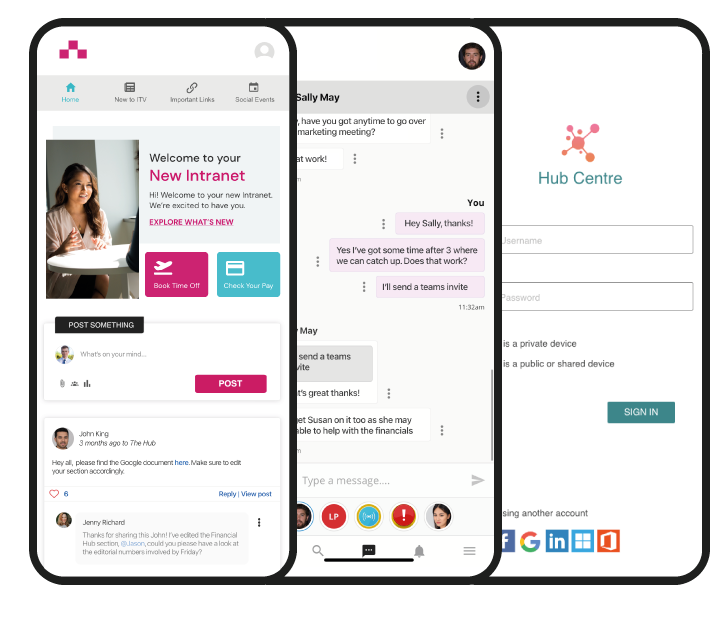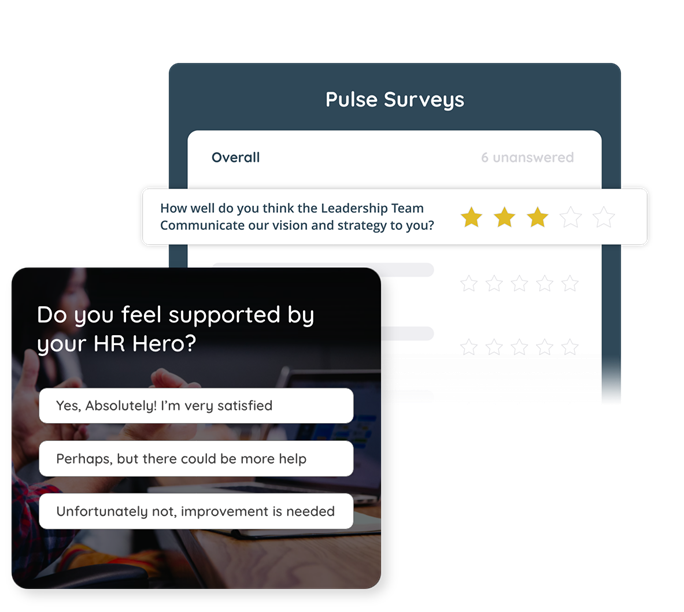You might not realise how much of an impact communication has in your workplace. You need to be communicating with employees properly so they can perform in their role properly and are aware of what’s going on in the business. When you don’t communicate properly it can cause all sorts of problems from ineffective collaboration, conflicts and low morale. In fact, 86% of employees have cited poor communication as the main cause of workplace failures.
Times of difficulty or crisis are when it’s essential that you don’t shy away from proper communication with employees, lack of information - and truth - can cause trouble in the rumour mill, loss of productivity and a fragmented sense of unity.
In this blog, we’ll be showing you how to communicate with your employees effectively during tough times.
How to communicate with your employees during difficult times
Communicate transparently
During times of difficulty, communication can be the defining factor of how your workforce moves forward. Keeping employees informed of everything going on is essential, so make sure your communications are open, transparent and honest. It’s vital that you communicate with employees first before any other stakeholders.
Employees should be in the know with what is going on from their senior leaders. Whatever is happening in the business, employees will eventually find out and so it’s important that leadership work with teams such as HR, PR and legal teams to create a strong statement.
Make sure you address three key areas:
- What is happening or has happened
- What decisions have been made
- What the plan is going forward
Use the plan going forward to show strength and a positive outlook on the situation. When employees see decisions being made to protect the success of the organisation it will help to move everything forward.
Talk about any lessons learned
Everything in life is a lesson or a blessing. Try to adopt a mindset of learning, ask yourself and ask your employees to give feedback on thoughts and solutions regarding situations, was everything handled well? How can we handle situations like these going forward?
Share your vision for the future
It’s really important to be clear and informative about how the business is going to move forward during times of uncertainty, being clear will help employees understand and inform them of how crucial their job role is. Make sure you reiterate this message and ensure managers are communicating with employees and offering any support and assistance.
Celebrate large and small wins
If morale is low it’s really important to celebrate all the positives - big or small - to keep spirits high and remind your team that you appreciate them and their work is valuable. Identify any wins when working on projects to boost confidence and productivity.
Ask for feedback
Asking your employees how they feel during difficult times is the better route to take rather than trying to fix everything yourself. Trying to solve problems without help and advice can create a negative culture where employees don’t feel that they can collaborate and fix problems together.
Ask your employees for honest feedback and their perspectives on situations, you can work through issues together and it will create a stronger team dynamic.
Utilise your channels correctly
Having a spokesperson who has clear knowledge of the situation, who has high credibility and can clearly articulate important messages and tailor comms around this message is essential for communicating crisis comms effectively and handling the situation with confidence.
Determine which channels you’re going to use. Will you use various channels depending on the audience and who uses what the most? Or will you have one set place for specific comms to centralise your message and reduce information overload? Oak’s Adaptive Intelligence will help get your messages to the right people at the right.

10 Ways to Improve Poor Communication in the Workplace
Pay Attention
When you’re communicating, really pay attention to how you’re communicating. Ask yourself questions… What is the most important thing I’m trying to get across here? Who is my audience, do they understand what I’m talking about or do I need to change the way I’m talking about it? What is the receiver's communication style?
Communicating well is not as easy as people think but with some prior thought and preparation, you’ll be able to get your messages across crystal clear. Another incredibly important aspect of communicating is listening.
By showing that you pay attention to your employees and show that you’re interested in who they are as people and their interests outside of work they’ll feel more comfortable around you and that element of trust and honesty will be there. Your employees will be more likely to communicate well with you if there is a level of trust.
Be Understanding of Different Communication Styles
When your role entails communicating and connecting with a lot of people then it’s important to take communication styles into play as we’re all human and not everyone communicates exactly the same.
Having all of these types of communicators in your business is essential as they all bring their strengths and so you must communicate with them effectively. There are four main styles of communication in the workplace:
Direct: Direct communication is clear and concise with no beating around the bush. What you see is what you get, with no hidden messages. People with a direct communication style just want actionable information that is straight to the point with no ‘fluff’.
Direct communicators don’t like small talk, they’ll zone out if the information isn’t relevant to them and want the information they need quickly so they can get straight to work. This communication style can come across as aggressive or assertive but the benefits of direct communication are that you know exactly what someone is thinking.
Analytical: Also known as functional communicators, this type of communication style focuses on the importance of detail and value. These communicators are focused on carefully devised plans, processes and preparation leaving no margin for error. These communicators are passionate about detail and so need every step of a project or process mapped out and explained.
Analytical communicators prefer hard data and facts over emotional stories and make logic based decisions rather than go with their intuition or gut feelings. They’re not people who tend to go with the flow and improve, however, their attention to detail means they notice details that others might miss. Make sure you map out each step of the process and explain not just the end goal, but why each step is important in achieving the end goal.
Collaborative: Collaborative communicators are all about employee voice and making sure everyone feels heard and valued. They want opinions and feedback galore from as many people as possible and therefore thrive in group projects.
These types of communicators will not make a decision unless everyone's opinion has been considered and tend to choose solutions that help the biggest number of people. They put others before themselves and will take longer to make decisions. Make sure you ask them for their opinion and perspective and give them firm deadlines so they have something concrete to work towards.
Expressive: Expressive communicators focus on social interactions and creating a positive atmosphere, these people like to move fast and have fun. Expressive communicators focus a lot on the “why” rather than the “how”.
They’re blue sky thinkers with big ideas and like having big discussions rather than focusing on details and instructions. They can change their mind a lot and focus on the future rather than the here and now. Communicate with expressive people by asking what their vision, thoughts and feelings are about projects and help them turn their ideas into practical solutions. Keep the number of projects relatively small so they can focus well.
Conduct regular Weekly Team Meetings
Creating a culture where teams catch up regularly and are aware of what each other is working on is an essential step of good communication. If your teams don’t talk to one another, how will you collaborate and innovate? Having scheduled meetings, will foster a sense of team spirit and create opportunities for team members to build good relationships with one another. This makes it easy for colleagues to communicate with one another outside of scheduled meetings.

Conduct regular 1:1s
It’s important to have a balance of group meetings and 1:1 meetings with individual employees. 1:1s are an amazing opportunity to really dive into what your individual team members are thinking and collecting feedback and insights.
Schedule 1:1s with your employees at dedicated times that best suit them throughout the week so they know that they have that time to talk about work and any other queries. These meetings can be for current tasks and priorities, discussing ideas and any problems employees are experiencing and their happiness at work.
Know your Audience
When communicating with people, really think about who you’re talking to… is it a department who have known you for a long time and understands you as a person or are they new employees who are in an unfamiliar environment and need a lot of explanation?
When communicating in the workplace, consider your audience and what they need to get out of this communication. What questions might they have, what details are essential for them to know, and what might they need you to expand and explain more about? Think carefully and consider their needs.
Recognise Great Employees
Imagine if you never told your employees what a great job they were doing? Your workforce would feel unmotivated and like they weren’t appreciated which can lead to unsatisfied employees. Make sure you’re properly communicating to employees when they’re performing well and recognise their hard work to make them feel valued.
Oak Engage has its own inbuilt Employee Recognition software so you can celebrate any work achievement big or small, and even celebrate moments like birthdays, work anniversaries and more!

Offer Proper Constructive Criticism
Giving criticism can be hard but there are ways to do it properly. When offering constructive feedback make sure you do it in private and try to put a positive spin on it. Find something positive about their work and then make a suggestion for how it needs to be improved or done differently. Offer constructive feedback in 1:1s so that it seems less like an isolated incident for the employee and more like a review of everything they're working on.
Use Intranet Platforms to Share Company Messages
Having a specialised digital workspace where employees know they can access company news, updates and events as they are announced is a great way of keeping employees up to date. If employees hear updates second-hand or from whispers around the office it can make them feel out of the loop and undervalued and so it’s important to have a central place where you can communicate to all your employees at the click of a button!

Ask for Regular Feedback
Getting feedback from staff is the best way to improve your company, your culture and the overall experience for your employees. Offering anonymous feedback surveys where your employees can be open and honest will enable you to get regular feedback on certain topics and thus continue to improve your workplace.
You’ll discover patterns and trends that might flag up any problem areas or ways that things can be done differently. And most importantly, you’ll find out what your employees care about and you’ll make their voices feel heard and valued. This alone has a huge impact on communication and employee engagement itself.

Make Resources & Documents Easily Accessible
Employees can spend a huge portion of their day just searching for the right documents that they need and endless content sources it can bring a huge hit to their motivation. Oak integrates with Office 365, Sharepoint and a range of other third-party platforms and has a powerful search tool so you can easily access and manage your content and employees can complete any task with ease anytime, anywhere from any device.
Conclusion
By learning about the causes of poor communication, thinking carefully about the way you communicate with people and using the right tools to allow you to communicate with various individuals in your workplace, you’ll be able to take your communication from poor to professional in no time.
Do you have any suggestions for addressing and transforming poor communication in the workplace? We would love to hear them on social media. Get in touch!




